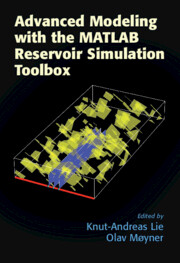Book contents
- Frontmatter
- Contents
- List of Contributors
- Preface
- Acknowledgments
- Navigating the Book and the MRST Modules
- Part I Grid Generation, Discretizations, and Solvers
- Part II Rapid Prototyping and Accelerated Computation
- Part III Modeling of New Physical Processes
- 7 Using State Functions and MRST’ls AD-OO Framework to Implement Simulators for Chemical EOR
- 8 Compositional Simulation with the AD-OO Framework
- 9 Embedded Discrete Fracture Models
- 10 Numerical Modeling of Fractured Unconventional Oil
- 11 A Unified Framework for Flow Simulation in Fractured Reservoirs
- 12 Simulation of Geothermal Systems Using MRST
- 13 A Finite-Volume-Based Module for Unsaturated Poroelasticity
12 - Simulation of Geothermal Systems Using MRST
from Part III - Modeling of New Physical Processes
Published online by Cambridge University Press: 20 November 2021
- Frontmatter
- Contents
- List of Contributors
- Preface
- Acknowledgments
- Navigating the Book and the MRST Modules
- Part I Grid Generation, Discretizations, and Solvers
- Part II Rapid Prototyping and Accelerated Computation
- Part III Modeling of New Physical Processes
- 7 Using State Functions and MRST’ls AD-OO Framework to Implement Simulators for Chemical EOR
- 8 Compositional Simulation with the AD-OO Framework
- 9 Embedded Discrete Fracture Models
- 10 Numerical Modeling of Fractured Unconventional Oil
- 11 A Unified Framework for Flow Simulation in Fractured Reservoirs
- 12 Simulation of Geothermal Systems Using MRST
- 13 A Finite-Volume-Based Module for Unsaturated Poroelasticity
Summary
Geothermal energy is renewable, always on, and available anywhere (at least in principle). Hot underground aquifers are therefore appealing as a source of green energy but also for large-scale energy storage, which is important to buffer the seasonal energetic imbalance associated with the use of renewable energies. The viability of a geothermal exploitation project is determined by a number of factors such as energy efficiency, storage capacity, economical aspects (e.g., drilling and operational costs), and compliance with legal regulations. Such assessments require a detailed characterization of the geology and physical properties of both the aquifer and aquiclude, groundwater chemistry, and flow properties. Proper understanding of these processes depends on accurate and flexible numerical simulation tools. In this chapter, we present geothermal, a module for geothermal simulations of low- to moderate-enthalpy geothermal systems. The module implements the equations for conservation of energy and conservation of mass for water and salt (NaCl), along with pressure-, temperature- and NaCl-dependent viscosity and density and other functionalities specific to geothermal problems. We demonstrate the accuracy of the module by benchmarking it with TOUGH2, a widely used groundwater flow simulator. We also show how geothermal can be used to simulate different geothermal applications.
Keywords
- Type
- Chapter
- Information
- Advanced Modeling with the MATLAB Reservoir Simulation Toolbox , pp. 491 - 514Publisher: Cambridge University PressPrint publication year: 2021
- Creative Commons
- This content is Open Access and distributed under the terms of the Creative Commons Attribution licence CC-BY-NC-ND 4.0 https://creativecommons.org/cclicenses/
- 1
- Cited by



